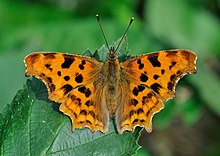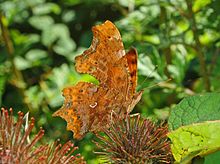Polygonia c-album
| Comma | |
|---|---|
 |
|
| Dorsal view | |
 |
|
| Ventral view of the hutchinsoni form showing light-coloured wing undersides | |
| Scientific classification | |
| Kingdom: | Animalia |
| Clade: | Euarthropoda |
| Class: | Insecta |
| Order: | Lepidoptera |
| Family: | Nymphalidae |
| Genus: | Polygonia |
| Species: | P. c-album |
| Binomial name | |
|
Polygonia c-album (Linnaeus, 1758) |
|
| Subspecies | |
|
Eight, see text |
|
| Synonyms | |
|
Nymphalis c-album |
|
Eight, see text
Nymphalis c-album
Polygonia c-album (comma) is a food generalist (polyphagous) butterfly species belonging to the family Nymphalidae. The angular notches on the edges of the forewings are characteristic of the Polygonia genus, which is why species in the genus are commonly referred to as anglewing butterflies. Comma butterflies can be identified by their prominent orange and dark brown/black dorsal wings. To prevent predation, both the larval and adult stages exhibit protective camouflage, mimicking bird droppings and fallen leaves, respectively. During the later stage of development, the larvae also develop strong spines along their backs. The species is commonly found in Europe, North Africa, and Asia, and contains several subspecies. Although the species is not migratory, the butterflies are strong fliers, resulting in an open population structure with high gene flow and increased genetic variation.
P. c-album belongs to the Nymphalidae family, the largest family of butterflies with 13 subfamilies. Within the Polygonia genus, a sister-group relationship between P. c-album and P. faunus is strongly supported by larval development analysis and synapomorphies. In both species, the adults and larvae have similar polyphagous habits. The Polygonia genus is also closely related to the genera Kanisha and Roddia, each containing a single species: K. canace and R. l-album.
P. c-album inhabit areas including Europe, North Africa, and Asia. It is primarily a woodland butterfly, living in low-density forests with sunshine and moist soil. Specifically, the species is commonly found in the woodland, country lanes, and garden areas of Norway, Sweden, and Great Britain. As a food generalist, or polyphagous species, comma butterflies can feed upon a variety of host plants, leading to widespread ranges across continents. In response to climate change, they are also undergoing range expansion.
...
Wikipedia
